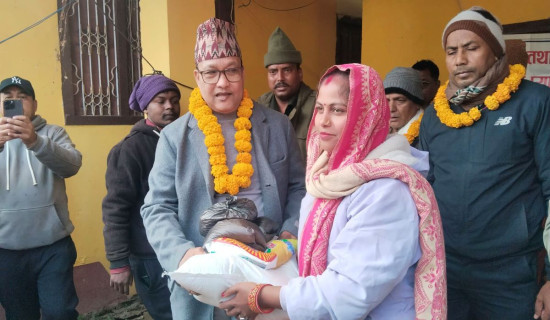- Thursday, 8 January 2026
Increasing Fast Food Frenzy Among Youth
While walking along the streets of major cities in Nepal, one can notice an abundance of food vendors on the sidewalks, selling chatpate, fritters, and momos, among other items. The displayed items look colourful and appealing, though they aren’t good for health due to the excessive amount of oil involved in their preparation. Consumption of such foods can be convenient for someone with a busy lifestyle, as they take less time to prepare. In Nepal, this growing fascination with fast food has not only eased the lifestyle of busy people but also contributed to the income of poor families who lack enough capital to build restaurants
and eateries.
Food vendors seen on the streets operate their businesses with low capital, and the best part about their business is that they don’t have to pay rent for setting up stalls on the street. Citing sanitary issues, the authorities of various cities in Nepal have swept away the businesses running on the streets. This step might aid in keeping cities clean, but it can’t keep people from consuming fast food. While the street stalls are secondary junctions for fast food, people have long relied on restaurants and cafes for fast food items. Fifteen years ago, street stalls were uncommon in Nepal, but they soon mushroomed with growing urbanisation.
Although the concept of fast food came much later in Nepal, its existence can be traced back to ancient civilizations, where street vendors in Rome and China sold ready-to-eat food to travellers and urban dwellers. Modern fast food took off in the 20th century, with White Castle blazing the way for other brands like McDonald's, KFC, and more. It is considered that White Castle first popularised the fast-food hamburger chain, and others followed suit. With the founding of McDonald's in 1940, the popularity of fast food reached new heights, turning it into a global phenomenon.
Around that time, there was no economic liberalisation in Nepal, restraining the fast-food phenomenon from seeping into Nepali society. Nepalis consume rice, wheat, grains, barley, and maize in the form of roti, Dal Bhat, and Tarakari. If a Nepali person born around 150 years ago were to see the fast-food craze of today, they would feel astonished.
The stark contrast between the food preferences of different generations would be striking for them. Burgers, pizza, fries, and momos have become staple foods for many young generations. While the middle-aged generation isn’t as fond of eating outdoors, young people, however, opt for quick meals, avoiding the importance of whole meals that contain the required nutrition for the body.
Eateries have become meeting places for young people where they hang out with friends and spend the whole day. Not only young people, but various informal groups and social clubs have adopted fast-food cafes as meeting places to hold discussions on diverse topics. This phenomenon goes against the essence of fast-food culture. If we look at the subject matter with a critical eye, we can say that our society and our ways are misguided; the concept of fast food emerged with the need to cater to busy people who are unable to prepare food due to a hectic schedule. In other words, fast food was not seen as a first-choice food. But the irony is that our society has completely changed course—people have been seizing time to enjoy themselves at fast-food eateries. The growing interest in fast food poses a question: Are we wasting money and time on something that’s not important
at all?
The marketing strategies of restaurants have been exceptionally successful in the recent past. We can see them sponsoring sports clubs and other programmes initiated by the youth. Also, the restaurants leave no stone unturned to make their place appealing. They seem to invest a lot in decoration and furniture to lure people. They make sure to provide a WiFi connection to every visitor, which might help people stay longer. Social media handling equally benefits their businesses as they vigorously promote their food products in the digital landscape. With the rise of food-ordering apps designed for mobile phones, the fast-food business has flourished more than ever, making it convenient for customers to relish the food from the comfort of their homes. The technological shift has enhanced the fast-food culture, and its consumption is more likely to grow in the coming years. Apps like Foodmandu, Foodmode Nepal, and BhojDeals have been catering to customers by helping people place their orders with a single touch.
Although fast foods are pleasing to the taste buds, their health consequences are serious. One must be conscious of the ingredients involved in the making of such foods. High calories can be found in fast foods with a substantial amount of saturated fats and refined carbohydrates. Regular consumption of foods containing such unhealthy ingredients increases the risk of obesity, hypertension, heart disease, digestive issues, and diabetes, among other diseases. Youth, being the largest consumers of such foods, must consider their eating habits to avoid ailments in the future. In many places, schools allow their canteens to sell junk and packaged foods, which must be discouraged. School canteens should only be allowed to sell quality foods containing all sorts of nutrition. At home, it’s the responsibility of parents to keep track of their children’s eating habits. Parents in Nepal are often seen offering packaged juices to their children. This can happen because of the misleading information regarding nutritional facts on the packet. They are all high in sugar, and it’s important to be aware that they do more harm than good.
With the rising popularity of fast foods, consuming traditional foods like rice, wheat, maize, and barley has become a rare occurrence. In village areas, restaurants specialising in fast food have emerged, catering to both locals and tourists. However, instead of experiencing authentic local cuisine, visitors often find themselves served familiar fast food options. Those involved in the hospitality industry should consider embracing and experimenting with local culinary delights rather than solely relying on globally available food items. Food is an integral part of our lives, and it’s important to be conscious of our eating habits. Despite the rising popularity of fast food, we must know that regular consumption comes at our own expense. The fewer fast foods we eat, the healthier we become.
(The author is a writer from Pokhara.)

















